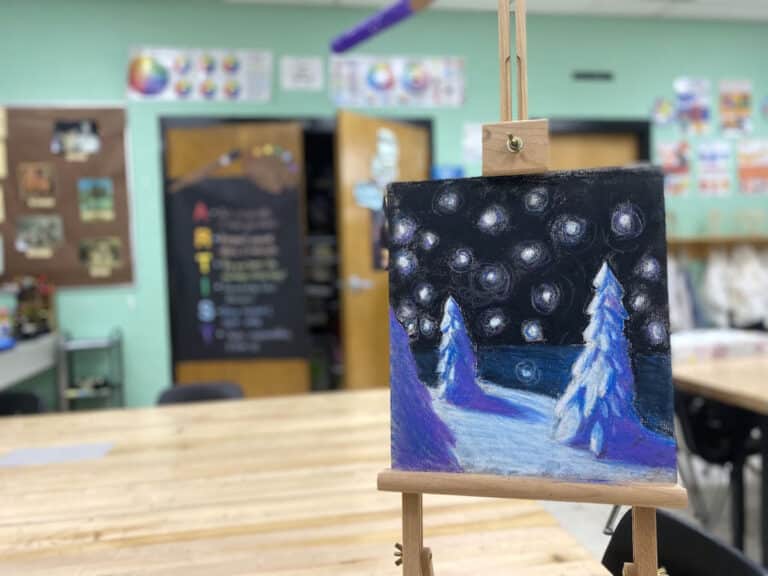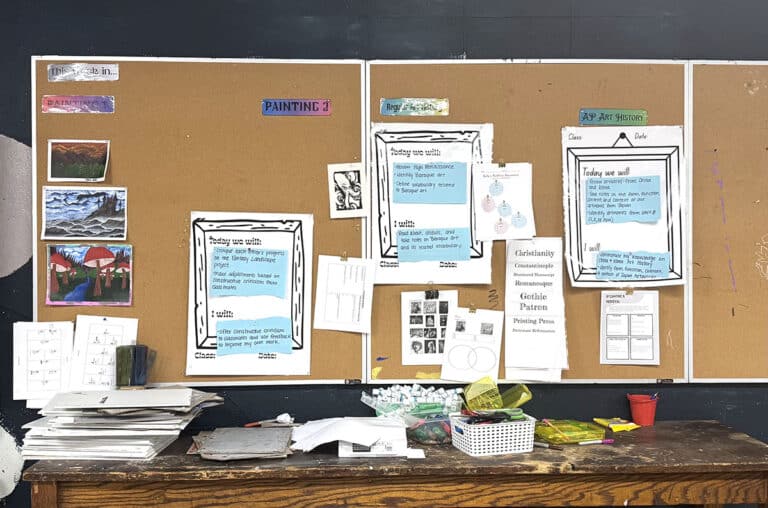We’ve all had stubborn students in our rooms. You know the symptoms: lack of effort, just going through the motions, or, my personal favorite, the eye roll! If you teach middle school, you’ve probably had more than your fair share of these types of behaviors.
As students get older they get cooler, a bit more cynical, and definitely more set in their ways. It’s easy to feel defeated with a classroom full of apathetic kids all day long. However, don’t despair.
Today I’m here with 5 effective tips for working with stubborn students in the art room.
1. Tap into their interests and include student choice.

As art teachers, we have the great luxury (or is it a curse?) of being able to modify our curriculums to meet the needs of our students. One of the most simple and effective ways to win over stubborn students is by tapping into their interests. This tip assumes that you’ve already spent some time building rapport with your students and have an environment where students feel safe to share a bit about themselves.
For example, in my mind, there’s no better subject for showing off a student’s grasp of composition, line, shape, and value than the bounty of my backyard vegetable garden. My students, however, do not match my enthusiasm and connection to fresh produce. I’ve had students ditch the veggies in favor of boxing gloves, a motocross helmet, and ballet shoes. I’m completely on board with all of these modifications as long as the students are still tackling the big objectives of the lesson. Let students have a choice in such secondary concerns. By embracing student choice, you can start to engage stubborn students.
2. Lower the originality hurdle.
“If it’s not 100 percent original, don’t even bother.” While this is a great stance to take with most of our students, the stubborn student may see it as a challenge. It seems like some big behavioral issues, like stubbornness and non-compliance, have roots in misunderstandings and deficient skills. Students would much rather look tough than show they’re struggling. Art teachers can do students a disservice by stressing originality above all else. Providing these students with a starting point or inspiration can side-step a student shutdown. Ease students into creation by letting them get their hands dirty first and trusting the creative, deep thinking and aesthetic evaluation will come.
3. Pull out your experimental and no-fail lessons.

When you’re trying to engage a stubborn student, pull out all the stops and bring out the project that’s a proven winner. You know the one I’m talking about. It’s the one kids can’t wait to do because they’ve seen their older siblings and friends do it. It’s the one that gets gasps in the hallway. It’s a legend. For me, that’s a stenciled t-shirt project. What students don’t like designing their own t-shirts?
I also find using fun and unusual materials is a big hit. Clay, spray paint, and blow torches (don’t ask) always go over great in my class. As I’ve moved up the Choice Spectrum, I’ve gotten to the point where once or twice a semester, I flat out ask my students what kind of project they’d like to work on next. These collaborative brainstorming sessions are always inspiring and empowering for students…even the stubborn ones.
4. Use technology as a hook.

When dealing with stubborn students, think about the tools and toys those students simply can’t do without. For many, that means some form of technology. Many students equate art to photorealistic drawing. If they can’t do that, then in their minds, they are horrible at art. So, try and engage them in a different way first. Photography and graphic art are great places to start. Try this fall photo lesson for elementary students, these digital radial designs for middle school students, or this narrative photo lesson for high schoolers.
5. Give it time, be patient, and practice empathy.
This strategy is the simplest and most effective, but it requires you to play the long game instead of looking for a quick fix. It doesn’t really require much more than removing yourself from the situation and realizing that the stubborn student’s behavior has absolutely nothing to do with you. If you can see that, you’ll have all the patience and understanding in the world. I truly believe that student frustration is the root of most non-compliance. If you can work with the student in their own way to get past that, you’ll set yourself, and your student, up for success.
If I’m being completely honest…I wasn’t always such a great student myself. We’ve got to understand and empathize with our own inner stubborn child! We often laud grown-ups for sticking to their convictions but condemn students for being stubborn. Look for a way to find some middle ground.
Are there ways to utilize a student’s stubborn tendencies to their benefit or even to the benefit of the entire classroom environment?
What tips do you have for dealing with stubborn students?
Magazine articles and podcasts are opinions of professional education contributors and do not necessarily represent the position of the Art of Education University (AOEU) or its academic offerings. Contributors use terms in the way they are most often talked about in the scope of their educational experiences.





